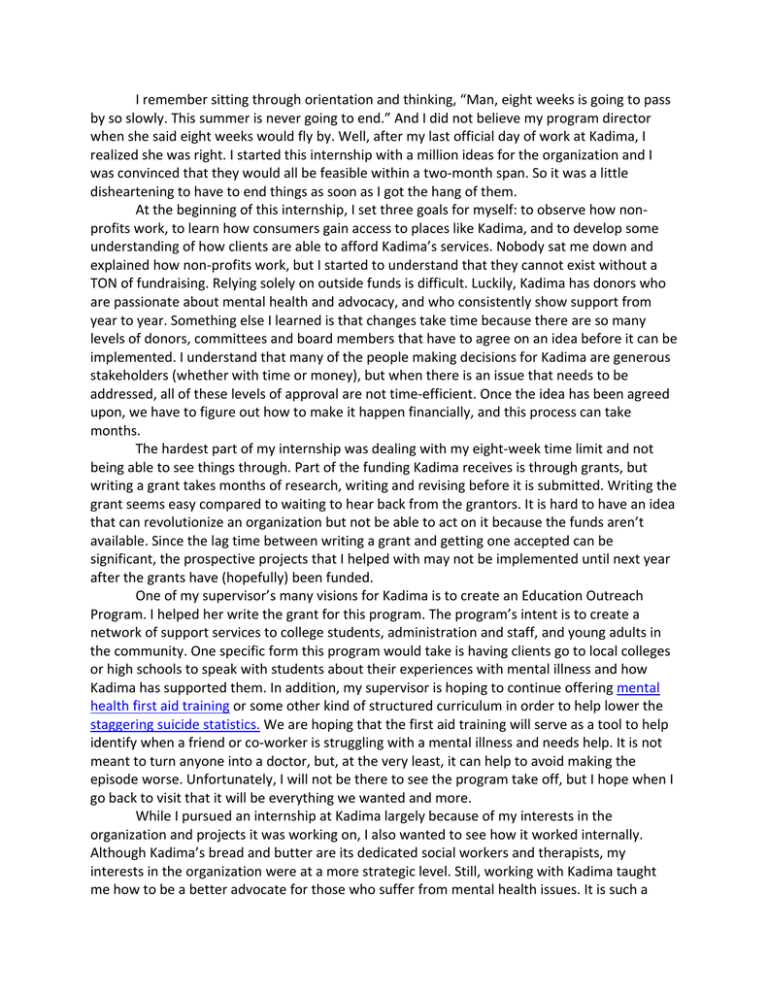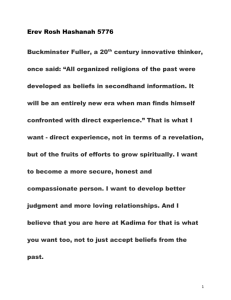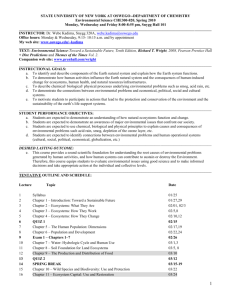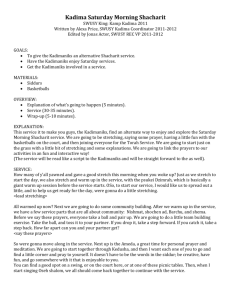I remember sitting through orientation and thinking, “Man, eight weeks is going to pass by so slowly. This summer is never going to end.” And I did not believe my program director
advertisement

I remember sitting through orientation and thinking, “Man, eight weeks is going to pass by so slowly. This summer is never going to end.” And I did not believe my program director when she said eight weeks would fly by. Well, after my last official day of work at Kadima, I realized she was right. I started this internship with a million ideas for the organization and I was convinced that they would all be feasible within a two‐month span. So it was a little disheartening to have to end things as soon as I got the hang of them. At the beginning of this internship, I set three goals for myself: to observe how non‐ profits work, to learn how consumers gain access to places like Kadima, and to develop some understanding of how clients are able to afford Kadima’s services. Nobody sat me down and explained how non‐profits work, but I started to understand that they cannot exist without a TON of fundraising. Relying solely on outside funds is difficult. Luckily, Kadima has donors who are passionate about mental health and advocacy, and who consistently show support from year to year. Something else I learned is that changes take time because there are so many levels of donors, committees and board members that have to agree on an idea before it can be implemented. I understand that many of the people making decisions for Kadima are generous stakeholders (whether with time or money), but when there is an issue that needs to be addressed, all of these levels of approval are not time‐efficient. Once the idea has been agreed upon, we have to figure out how to make it happen financially, and this process can take months. The hardest part of my internship was dealing with my eight‐week time limit and not being able to see things through. Part of the funding Kadima receives is through grants, but writing a grant takes months of research, writing and revising before it is submitted. Writing the grant seems easy compared to waiting to hear back from the grantors. It is hard to have an idea that can revolutionize an organization but not be able to act on it because the funds aren’t available. Since the lag time between writing a grant and getting one accepted can be significant, the prospective projects that I helped with may not be implemented until next year after the grants have (hopefully) been funded. One of my supervisor’s many visions for Kadima is to create an Education Outreach Program. I helped her write the grant for this program. The program’s intent is to create a network of support services to college students, administration and staff, and young adults in the community. One specific form this program would take is having clients go to local colleges or high schools to speak with students about their experiences with mental illness and how Kadima has supported them. In addition, my supervisor is hoping to continue offering mental health first aid training or some other kind of structured curriculum in order to help lower the staggering suicide statistics. We are hoping that the first aid training will serve as a tool to help identify when a friend or co‐worker is struggling with a mental illness and needs help. It is not meant to turn anyone into a doctor, but, at the very least, it can help to avoid making the episode worse. Unfortunately, I will not be there to see the program take off, but I hope when I go back to visit that it will be everything we wanted and more. While I pursued an internship at Kadima largely because of my interests in the organization and projects it was working on, I also wanted to see how it worked internally. Although Kadima’s bread and butter are its dedicated social workers and therapists, my interests in the organization were at a more strategic level. Still, working with Kadima taught me how to be a better advocate for those who suffer from mental health issues. It is such a significant problem that seems to be ignored because of the stigma that surrounds it. Kadima taught me that it is OK to talk about mental health, and that in order to move forward and erase the stigma we have to talk about it. To quote one of my favorite clients, Lora: If someone has a broken arm then everyone feels bad for them because they can see what is wrong. Mental illness cannot be seen. If there is something wrong and I need help, it is much less obvious than a physical problem. Being at Kadima only affirmed that more people need to stand up for those with mental illness. Being an HSSP major at Brandeis University is an excellent opportunity to advocate for people with mental illness. I can learn the fundamentals of the heath‐care system and how it works in the classroom. This major is all about the relationship between health‐care systems and consumers. I am not sure what career I am going to pursue, however, the people skills I learn about as a major will help me wherever I end up. With a major so dedicated to helping other people, I plan to join the Disabilities Activism group on campus that was chartered last semester. This group is looking to educate students on campus about different types of disabilities that students face, and how we can help make their lives better. After my time at Kadima, I am going to make sure to attend their meetings in order to identify opportunities to help people in need. I can use the marketing and advocacy skills I learned to help the Disabilities Activism group and to get the word out about it to other students. I think an HSSP student interested in mental health or social work would have an incredible time at Kadima. Kadima is a safe place for understanding the needs of individuals afflicted by mental illness and it is a good place to see what changes need to be made in order to truly make a difference in the community. Additionally, Kadima has a number of connections with outside organizations that also impact the community in various ways. My one regret is not asking to do more and to be more involved with the clients. My supervisor was more than willing to let me do anything I wanted as long as I finished the tasks she assigned; had I known about the clinical activities – volunteering at gardens, animal shelters, art exhibits, substance abuse groups, weekly yoga sessions, and so on – sooner I would have prioritized those over some of my other tasks. Especially during an internship an intern should feel comfortable asking her supervisor to do something if it interests her. I had such a unique experience at Kadima that, in spite of my inexperience in the health‐care field, I’m quite confident that it will be difficult to match. I miss everyone already!



